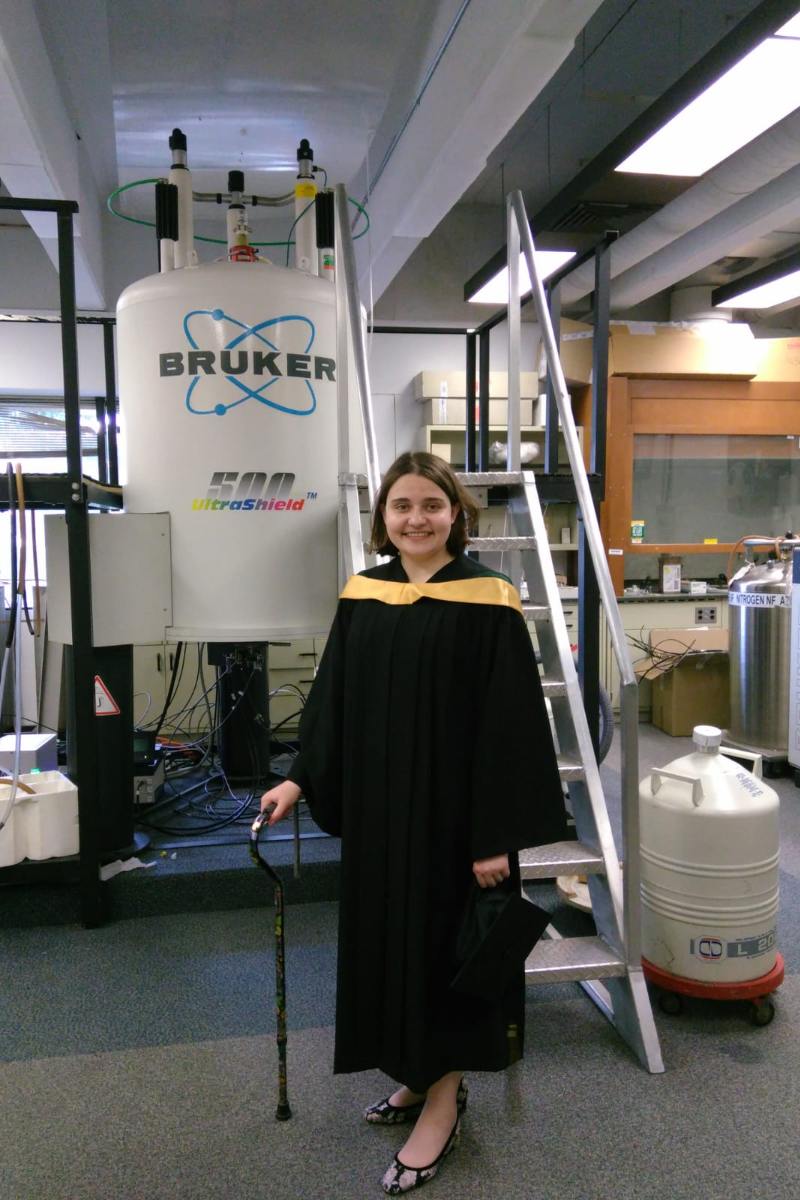
Maria Matlinska is pictured here in front of a nuclear magnetic resonance (NMR) spectrometer in the solid-state NMR lab on the day she graduated with her undergraduate degree. Image courtesy of Cecilia Xiang.
Over the last 10 years the undergraduate student body in the University of Alberta's Faculty of Science has boasted gender parity, with just over half of bachelor of science students identifying as female. These numbers, however, drop to 36 per cent in graduate programs, and less than a quarter of faculty members are women.
Diversity and representation in the highest ranks of academia is an issue of which recent chemistry graduate Maria Matlinska is keenly aware. And it's one she hopes to help change.
"Diversity goes beyond gender. It includes ethnicity, ability, religion, and sexuality. It all intersects," said Matlinska. "These basic social problems are still here. Representation is important because it allows you to see yourself somewhere. It helps you understand where it is that you could go as a scientist or in your career."
Matlinska has been involved in undergraduate research throughout her degree, studying with Vladimir Michaelis, assistant professor, and Roderick Wasylishen, professor emeritus in the Department of Chemistry.
Recently, Matlinska and 10 of her undergraduate colleagues attended the Western Canadian Undergraduate Chemistry Conference (WCUCC). Of the UAlberta students in attendance, nine were women, and three of those women won awards. Alongside fellow undergraduate students Irene Shkolnikov and Anna Kim, Matlinska took home two, including second place for an oral presentation and first place for the best presentation in physical and theoretical chemistry. But her experience at WCUCC was about a lot more than bringing home the glory, she said.
"Going to these conferences is for me. It is to build my career and CV, gain experience, expose myself to new ideas, and to network. But it's also about being a representative of this group of young, female scientists," said Matlinska. "If there's a person who needs support or reassurance, and they see us going, presenting, and winning awards, that's good. It is important to share our success so other students see that there are things out there regarding research that they can try and succeed in, with the support of other women."
Beyond that, Matlinska explains, it's important to get majority groups actively involved in supporting efforts toward improving diversity and representation. "This can mean inviting female speakers for public lectures and conferences, promoting the work of female students and colleagues, and encouraging female scientists to pursue conference and training opportunities."
EDI Tips to get you started
- Question yourself about your biases.
- Try the online Harvard Association Test to find out more about the biases you might have.
- Actively promote individuals from underrepresented groups.
- Inviting a speaker? Recommending people for a new job? Ensure your short-list contains equal numbers of men and women as well as ethnic and cultural diversity.
- Be inclusive!
- Planning an event or hosting a visitor? Ensure the location is accessible for persons with physical disabilities. Working in a group? Actively seek out input from all individuals and provide multiple ways for people to participate, from speaking up in a meeting to sending ideas through email to having short one-on-one conversations.
Interested in learning more about the state of diversity in the Faculty of Science? Read our second diversity report, or visit the diversity hub on our website.
In February 2019, UAlberta launched its Equity, Diversity and Inclusion (EDI) Strategic Plan. The plan sets out institutional priorities and goals over the next four years, with special emphasis in the first year on establishing improved systems for data collection (both quantitative and qualitative) to support target setting and identify specific barriers, on developing resources to integrate EDI considerations into research and teaching, and on sustaining and enhancing training and development across the university.